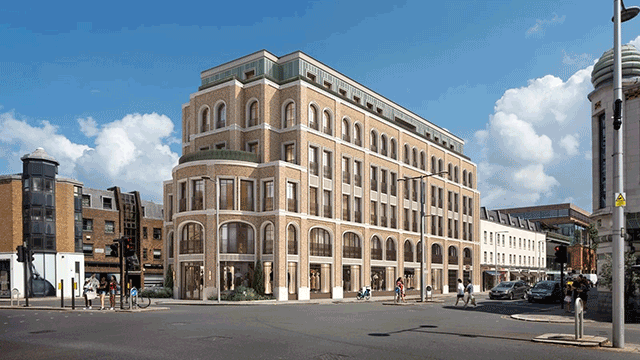DECISION
1. This reference relates to part of the land acquired by the acquiring authority under the South Northamptonshire Council (Deanshanger Water Tower Site) Compulsory Purchase Order 2006. A general vesting declaration was made on 26 September 2007 and the land vested in the council on 25 October 2007. The claimants assert that they had possessory title to part of the land and that they are entitled to compensation. Such compensation, they say, would properly be assessed as a share of the development value of the land, taken with adjoining land owned by the council, for which outline planning permission was granted in 2003, and renewed in 2006, for residential development. It appears that the most likely form of development would be a pair of detached bungalows.
2. The reference was made on behalf of the acquiring authority under paragraph 4(1)(c) of Schedule 1 to the Compulsory Purchase (Vesting Declaration) Act 1981, referring to the Lands Tribunal a notice of objection to severance that the claimants had served on them. The claimants, however, recognised that the notice of objection to severance was misconceived and by agreement the reference has taken effect instead as one made to determine the amount of compensation payable to the claimants. The acquiring authority do not accept that the claimants had the interest that they claim to have had in the subject land, and on 3 February 2009 I ordered that the issue of whether the claimants had acquired title to the reference land at the date of vesting should be determined as a preliminary issue at a preliminary hearing.
3. The order land is a triangular area situated to the rear of 36 and 38 High View and to the side of
4. On 3 November 1992 the council served on Mr Picton notice under section 215 of the Town and Country Planning Act 1990 requiring the demolition of the water tower and removal of all debris from the site. Section 215 enables a notice be served in respect of land that adversely affects the amenity of the area requiring steps to be taken for remedying the condition of the land. It must be served on the owner and occupier of the land. It appears that Mr Picton appealed against the notice. On 28 January 1993 his solicitors, Baileys, wrote a letter to the council’s solicitors. (The letter to which it was a response is not in the trial bundle and was not produced). It enclosed a plan on which were marked a number of areas. There was a defined triangle of land, in the middle of which was shown the water tower. The north-east side of the triangle was the boundary of the garden of 36 High View and the western half of the boundary of the garden of number 38 as it was before extension. The western boundary was the tarmac path to the point where it terminated at the curtilage of
5. The letter was in the following terms:
“Thank you for your letter of 27 January, on which we have taken our client’s instructions.
We note your reference to ‘the material part of the land’. In our view, the material part, which is clearly identifiable on site, is that area lying beneath the water tower. On the original plan served with your client’s Notice, this formed the larger part of an area described as Area B. For your convenience we enclose a further copy of the plan with the land in question hatched and edged red. You will appreciate that the remaining part of Area B is enclosed and forms an extension of our client’s garden. We maintain that this small area is irrelevant in these proceedings.
Area A has no significance to our client’s case, although we are instructed that in the past it has been used by our client’s neighbour, Mr Westwood. Certainly, our client is happy to acknowledge he maintains no claim to it. Area E is in fact an oil tank belonging to your client and has no bearing on this case. Area D is indeed occupied by our client but, again, this land was not material to the Notice.
In the circumstances, therefore, although your client’s willingness to consent to our client’s application is appreciated, we suggest that an appropriate order would be confined to cancellation of the Notice on terms that our client concedes that he has no claim to ownership (by adverse possession or otherwise) of the material land ie the land hatched red on the plan we enclose.
We look forward to hearing from you shortly in the hope that the present hearing date can be vacated on an agreed basis. Should you wish to discuss the matter, please refer to the writer.”
Following that letter it appears that the section 215 notice was withdrawn.
6. In 2000 the council entered on the land and demolished the water tower (at a cost, it is said, of £55,000). A fence dividing the claimants’ garden, as it was then enjoyed, from the water tower site had to be removed in order to enable demolition to take place. It consisted in one section of iron spiked railings backed by PVC panels and in another section of wooden fencing similarly backed. Mr Picton erected a new fence in January 2001 along a different alignment.
7. In July 2005 the claimants applied to the Land Registry to register possessory title to the land bounded by the new fence, consisting of Area D as shown on the plan accompanying Baileys’ letter of 28 January 1993, the northern tip of Area B as there shown and also an additional part of the water tower site consisting of about half of the rest of Area B. The council objected to a registration in these terms. The Land Registry registered with a possessory title the first two parts (Area D and the northern tip of Area B), and they said in relation to the rest that Mr and Mrs Picton would have to make a fresh application if they believed that they had acquired rights over the other land. No further application was made.
8. The CPO was made on 3 May 2006. It included the part of Area B that had been excluded from the registration. The claimants objected to the CPO, and a public inquiry was held on 10 January 2007. In confirming the order the Secretary of State accepted the recommendation of the inspector that two small slivers of land, one on the north side adjoining the garden of number 36 High View and one on the east side adjoining the rest of the claimants’ land should be excluded.
9. Evidence for the claimants was given by the claimant Mr Picton and by two neighbours, Mr Roger Welling of 28 Meadow View and Mr Ronald Goodman of
10. Mr Picton said that the land, which he described as the first land and corresponded to that in respect of which the Land Registry registered the possessory title, was incorporated into the claimants’ rear garden in 1975. In September 1974 he removed a section of the hedge and wrought iron railings at the bottom of the garden to obtain access onto part of the water tower site, and he formed a temporary gate at the southern end of the tarmac path to give access to the site for his van and a boat. In part of the area he started to keep chickens, and this arrangement continued until 1990, when the last chicken died. After that they used the area to grow vegetables.
11. On 5 November 1992, Mr Picton said, the council served on him the section 215 notice requiring him to arrange for the demolition of the water tower. After receiving legal advice he declined to do this. His appeal against the notice was due to be heard on 5 February 1992 before the local magistrates, but following consultation between the parties the notice was withdrawn, leaving each party to meet its own costs. Mr Picton said that he had not agreed the proposal in Bailey’s letter of 28 January 1993. He had left the matter in the hands of his solicitors. He never approved the letter and had never had a copy of it.
12. In July 2000, Mr Picton said, he received notification from Mr Wigley on behalf of the council that they were proposing to arrange for demolition of the water tower. It was he that had been pressing to have the tower removed. To facilitate the execution of the work he agreed to release possession of the part of the site that he had been occupying and he also agreed to the removal of a substantial portion of the wrong iron railings around the perimeter of the site, a fence and two trees. The council refused his request on completion of the work to reinstate the fence, and in January 2001 he bought the necessary fencing materials and erected a close-boarded fence, enabling him to take up possession of the site which he had been occupying for 24 years.
13. Mr Picton said that the area outside the garden fence, which he had surrounded with chicken wire fencing was occupied by himself and his wife. The purpose of the chicken wire fencing was not just to keep the chickens in but to exclude people from the land.
14. Mr Welling said that he had lived at 28 Meadow View since 1966 and had known Mr and Mrs Picton since they moved to their house in 1968. In about 1974 they started to cultivate an area of land as part of their garden, enclosing it within wrought iron railings along the edge of the water tower site. At the same time they removed sections of ledge and wrought iron railings to obtain access to areas of the water tower site that they then used for the keeping of chicken and growing vegetables. He said that he had seen a boat on the water tower site. There was fencing to keep the chickens in, and the chickens were under the water tower, but he could not say where the fencing was.
15. Mr Goodman said that he owned and occupied the house at
16. Evidence for the acquiring authority was given by Duncan Charles Alan Wigley, their Estate Surveyor. He said that he had been in the post since April 1998 and had had conduct of the file relating to the water tower site since that time. He had not seen the water tower site before this. There had been complaints from some local residents and parish councillor about the dangerous condition of the water tower. He visited the site on at least two occasions prior to the demolition of the tower. His recollection was that all the land under the water tower was at that time derelict. He did not recall ever seeing a gate at the southern end of the tarmac path.
17. For the acquiring authority Ms Lucinda Rowley submitted that the claimants had not been able on the evidence to make out a case for adverse possession. They were unable to demonstrate factual possession and had difficulty in identifying the area of land that was claimed. The Baileys’ letter said that Mr Picton did not have an interest in the land, and Mr Picton failed to give a satisfactory explanation about this.
18. Mr Howard submitted that the evidence established the necessary 12 year period of adverse possession. The claimants had demonstrated both factual possession and an animus possidendi. They had erected fencing on the water tower site to keep chickens in and people out; they had formed a vehicular access and had used it; and they had kept chickens on the land between 1976 and 1990 and had after that used it for growing vegetables.
19. It is a major shortcoming of the claimants’ case that, as Mr Howard accepted, they have not identified the land in respect of which they claim compensation. Two sketch plans, which are admitted to be inaccurate, fail to identify with any consistency or precision the reference land. This is not necessarily fatal to their case. If they were able to establish that they had possessory title to at least some of the land that was the subject of the CPO, it could perhaps be left to the substantive part of these proceedings to establish whether such area was sufficient to entitle them to the share of the development value that they claim. They have, however, in my judgment failed to make out a case for possessory title.
20. On the evidence, I find, it is sufficiently clear that the claimants used the land under the water tower for their chickens and kept the chickens in by means of a wire netting fence. There is, however, nothing to show when that use began and how long it continued, other than the witnesses’ different references to 1974 and 1976 as the start date and to 1990 as the year up to which the use is said to have continued. I find also that some vehicular means of access was made onto the site from the tarmac path and that on at least some occasions Mr Picton brought a van and a boat onto the land. I am not satisfied, however, that this was more than occasional. I am not satisfied, therefore, that possession for the requisite 12-year period has been shown.
21. In any event I am not satisfied that the claimants, in using the land as they did, had any intention of possessing it. It was in essence a casual use of waste land, in marked contrast to use of the area to the east which Mr Picton had enclosed with a PVC fence so that it became part of his garden. The crucial point, however, is that the land to which the claimants say they have acquired possessory title did not consist simply of the surface on which they kept their chickens. It included the water tower, a massive structure that formed part of the realty. There is nothing to indicate that the claimants regarded themselves as possessing the water tower itself. On the contrary the indications are that they sought to disclaim the responsibility that would have fallen on the occupiers under the section 215 notice, and Mr Picton said that it was he that later pressed the council to remove the tower. On the evidence Mr Picton’s interest was only in using parts of the surface of the land that were not occupied by the legs of the tower. He thus had no mind to possess or exercise control over the totality of such land as the claimants assert that they acquired by adverse possession. This finding is fatal to the claim. The claimants had no interest in any of the land that was the subject of the CPO and the vesting declaration.
22. This conclusion, I would add, is very obviously in accordance with the overall merits of the case. The claim is for a share of the development value of the water tower site and the council’s land to the west. But such value has only become realisable through the demolition of the tower, something which the claimants would not do themselves. It is a wholly unmeritorious claim.
23. The reference must be dismissed. The parties are now invited to make representations on costs, and a letter on this accompanies this decision, which will become final when the question of costs has been determined.
Dated 22 May 2009
George Bartlett QC, President










